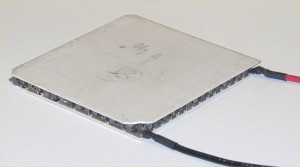Excellent demonstration of physics using popsicle sticks. Lots more here, including on how to make popsicle stick bombs and snakes (basically the tension of the structure gets released to create the movement).
Tag: physics
Faster than Light
Physicists at CERN believe they’ve measured neutrinos moving faster than the speed of light. Since most of modern physics is based on the speed of light being the upper speed limit for practically everything, (remember, in E=mc2, c is the speed of light) this is somewhat of a big deal. NPR has an article:
Notes
1. Neutrinos themselves are quite fascinating and elusive particles. Sciencemadefun has a nice video explaining what is a neutrino.
2. Victor Stenger provides an interesting perspective on these results. He points out that the theoretical particles, tachyons, move faster than light, but they can’t move slower than light, so, seen from the point of view of a tachyon, time would move backward. Only photons move at the speed of light.
Bird Poop: Force at Impact
In response to a question asked on the Car Talk radio program, Rhett Allain does the math to find out if falling bird poop can crack a windshield.
The answer: maybe. There are just a lot of assumptions that have to be made. Is falling bird poop spherical? What’s its density? How does the bird poop deform on impact? What is the compressive strength of automobile glass?
This is however an excellent real-life application of back-of-the-envelope physics and algebra. It required calculating:
- the volume of the poop – extrapolated from the diameter of the residue on the windshield;
- the terminal velocity of the poop – the velocity where gravity’s force is exactly counterbalanced by wind resistance so the poop is at its maximum speed;
- the force of impact – calculated using the work done as the poop splatters;
- and the pressure imparted by that force.

The Power of Graphs
A couple days ago I had students present their physics lab reports to the class. They did a good job, but I think I need to emphasize the importance of including graphs in their results. It’s much harder to look for trends and patterns in the data without charts, especially when presenting to an audience.
An interesting political science study (via Yglesias) found that it’s much easier to change people’s minds when you show them graphs, even when people don’t want to believe what you’re telling them.
[P]eople cling to false beliefs in part because giving them up would threaten their sense of self. Graphical corrections are … found to successfully reduce incorrect beliefs among potentially resistant subjects and to perform better than an equivalent textual correction.
–Nyhan and Reifler (2011): Opening the Political Mind? The effects of self-affirmation and graphical information on factual misperceptions

Teachers know how hard it can be to correct misconceptions – people tend to stick with the first thing they learned – so it’s good to see that graphical corrections can make a big difference.
Fortunately, my physics students are changing over to math next week, so we’ll be able to use their experimental data to draw lines, find gradients and do all sorts of interesting things.
Energy in the Nucleus of the Atom
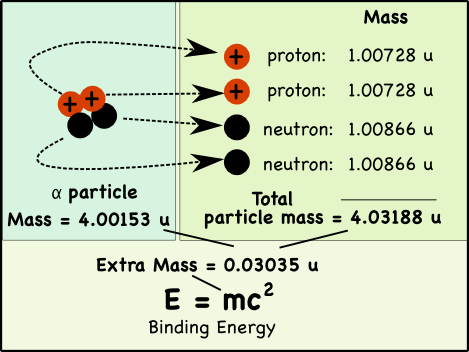
If you pull apart the nucleus of an atom, you’ll find that the mass of its parts is greater than the mass of the original nucleus. That extra mass is where nuclear energy comes from; it’s called the binding energy.
How so?

Take a helium atom for example. Its nucleus typically has two protons and two neutrons*, which in nuclear physics is usually called an alpha particle (α).
While we usually say that the mass of a proton is 1 atomic mass unit (u), its actually a little heavier. The mass of a proton is 1.00728 atomic mass units (u), while neutrons weigh 1.00866 u.
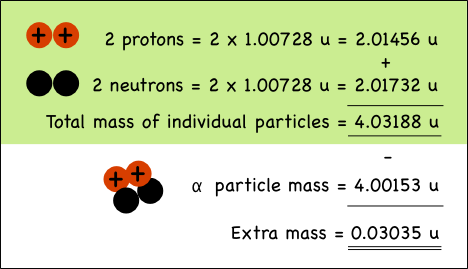
The combined mass of the two protons and two neutrons in the helium nucleus is 0.03035 atomic mass units more than the mass of a helium nucleus made up of the very same particles.
Why?
The one equation that everyone remembers from Einstein (perhaps from all the t-shirts) is:
![]()
Energy (E) is equal to mass (m) times some constant (c is the speed of light) squared. What it means is that mass is energy, and vice-versa.
When the four nucleons combine, the extra mass is transformed into the energy that holds them together in the nucleus of the atom. The mass can be directly converted to energy, the binding energy of the atom.
How much energy is released?
Somewhere around 10,000 times more energy is released from a single nuclear reaction compared to a single chemical reaction (like the combustion of TNT).
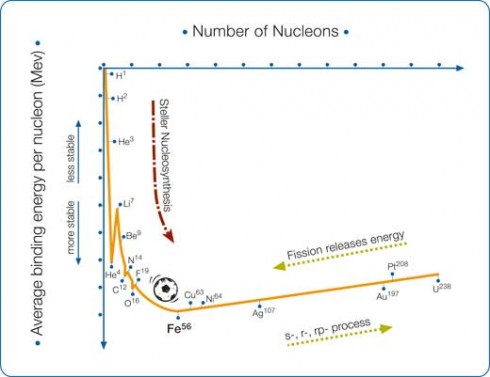
Footnotes
* Helium with two neutrons would be written ![]() , where the bottom number is the number of protons and the upper number is the atomic mass, which is the sum of the number of protons and the number of neutrons.
, where the bottom number is the number of protons and the upper number is the atomic mass, which is the sum of the number of protons and the number of neutrons.
Collapsing a Milk Jug: Atmopheric Pressure and the Ideal Gas Law
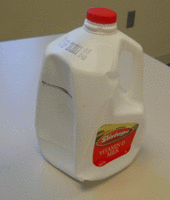
Place a little hot water (400 ml at 94-100°C) into a plastic, gallon-sized, milk jug. Give it a moment to warm the air in the jug, then put the cap on and seal tightly (hopefully airtightly).
As the air in the jug cools the gas inside with shrink, reducing its pressure, and causing the atmospheric pressure to push in the sides of the jug.
Admittedly, this experiment is a little more dramatic if you use a metal tin, but it works well enough with the milk jug to surprise and impress.
Heat and Hurricanes
What could possibly go wrong?
— Kai Ryssdal (2011) in Freakonomics: Preventing a hurricane on Marketplace by American Public Radio.
In what one can only hope is an extremely tongue-in-cheek article, Marketplace discusses how we might geoengineer a solution to stop hurricanes forming.
Hurricanes get their energy from the warm surface waters in the tropics. The warm water evaporates, transferring heat from the oceans to the atmosphere as latent heat in the form of water vapor. As the air rises, the water vapor condenses to form water droplets (clouds) releasing the stored heat into the air, causing the air to rise faster, sucking up more moisture, and setting up a positive feedback loop that turns storms and hurricanes.
But they need a constant supply of warm water.
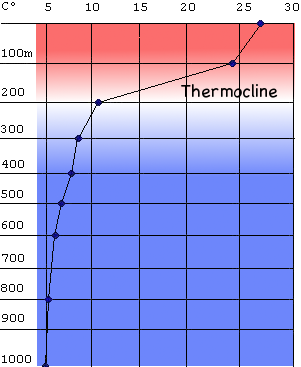
Unfortunately for the storms, the warm water in the tropics is only a thin layer, a couple of hundred meters deep, that sits above about 3,000 meters of colder deep-water. As the storms suck up the heat and moisture, they stir the oceans, cooling down the surface water, and leaving cooler water in their wakes. The cooler water means that subsequent storms have access to less energy.
The energy in the atmosphere and oceans “wants” to distribute itself evenly over the surface of the Earth. Hurricanes are just one violent means of moving heat from the tropics to the poles, and from the surface to the depths of the oceans.
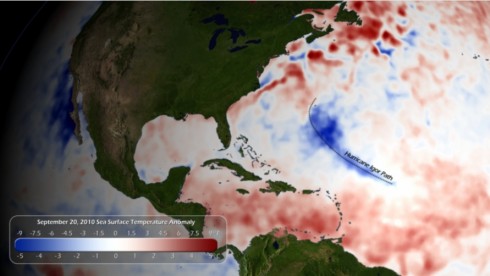
NOAA’s National Hurricane Center monitors sea-surface temperatures closely: it’s one of the key factors that go into their predictions of how bad the hurricane season is going to be, and what path a storm might take.
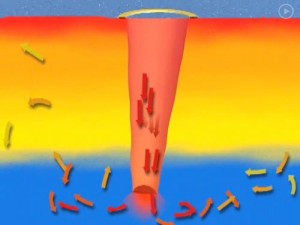
The suggestion in the Marketplace article is that we could build about 10,000 long tubes (called Salter Sinks) to connect the warm shallow surface water to the colder water below the thermocline. Wave energy at the surface would drive the warm water downward, causing mixing that would reduce the temperature of the surface water the storms feed off.
The devices might cost tens of millions of dollars per year, but that would be a lot less than the cost in property damage alone of a large storm like Irene, not to mention the loss of life it would prevent.
Apart from the “benign” environmental impact (according to Stephen Dubner) the only real question left is:
What could possibly go wrong?
Infrared Cloak
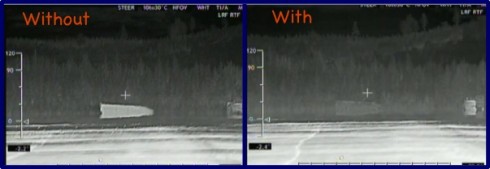
In an interesting application of thermodynamics, BAE Systems has developed panels that can be placed on a tank to mask what it looks like to infra-red goggles, or help it fade into the background.
The panels measure the temperature around them and then warm up or cool so they’re the same temperature and therefore emitting the same wavelength of infrared light. So someone looking at the tank with infra-red goggles would have a harder time distinguishing the tank from the background.
The panels are thermoelectric, which means they use electricity to raise or lower their temperatures, probably using a Peltier device.
Peltier devices, also known as thermoelectric (TE) modules, are small solid-state devices that function as heat pumps. A “typical” unit is a few millimeters thick by a few millimeters to a few centimeters square. It is a sandwich formed by two ceramic plates with an array of small Bismuth Telluride cubes (“couples”) in between. When a DC current is applied heat is moved from one side of the device to the other – where it must be removed with a heatsink. The “cold” side is commonly used to cool an electronic device such as a microprocessor or a photodetector. If the current is reversed the device makes an excellent heater.
— Peltier-info.com: Peltier Device Information Directory
